Comparison of On-Premise, Hosted and Cloud ERP Systems
VerifiedAdded on 2023/06/07
|16
|5198
|106
AI Summary
This report provides a comparison of On-Premise, Hosted and Cloud ERP Systems. It discusses the benefits, challenges and risks associated with each system. The report explains the usage and explanation of each system with case studies. It also includes a system overview of ERP and a list of references.
Contribute Materials
Your contribution can guide someone’s learning journey. Share your
documents today.
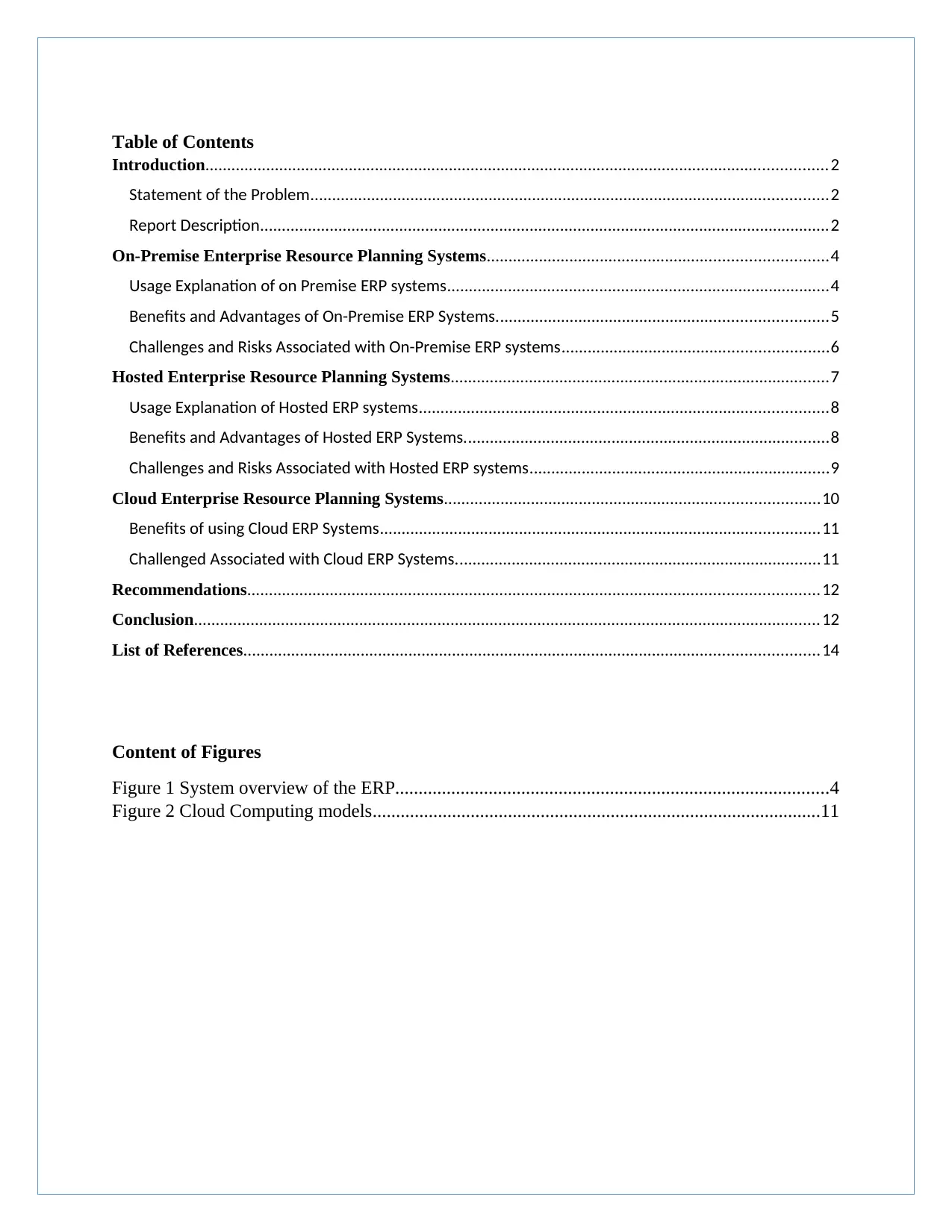
Table of Contents
Introduction...............................................................................................................................................2
Statement of the Problem.......................................................................................................................2
Report Description...................................................................................................................................2
On-Premise Enterprise Resource Planning Systems..............................................................................4
Usage Explanation of on Premise ERP systems........................................................................................4
Benefits and Advantages of On-Premise ERP Systems............................................................................5
Challenges and Risks Associated with On-Premise ERP systems.............................................................6
Hosted Enterprise Resource Planning Systems.......................................................................................7
Usage Explanation of Hosted ERP systems..............................................................................................8
Benefits and Advantages of Hosted ERP Systems....................................................................................8
Challenges and Risks Associated with Hosted ERP systems.....................................................................9
Cloud Enterprise Resource Planning Systems......................................................................................10
Benefits of using Cloud ERP Systems.....................................................................................................11
Challenged Associated with Cloud ERP Systems....................................................................................11
Recommendations...................................................................................................................................12
Conclusion................................................................................................................................................12
List of References....................................................................................................................................14
Content of Figures
Figure 1 System overview of the ERP.............................................................................................4
Figure 2 Cloud Computing models................................................................................................11
Introduction...............................................................................................................................................2
Statement of the Problem.......................................................................................................................2
Report Description...................................................................................................................................2
On-Premise Enterprise Resource Planning Systems..............................................................................4
Usage Explanation of on Premise ERP systems........................................................................................4
Benefits and Advantages of On-Premise ERP Systems............................................................................5
Challenges and Risks Associated with On-Premise ERP systems.............................................................6
Hosted Enterprise Resource Planning Systems.......................................................................................7
Usage Explanation of Hosted ERP systems..............................................................................................8
Benefits and Advantages of Hosted ERP Systems....................................................................................8
Challenges and Risks Associated with Hosted ERP systems.....................................................................9
Cloud Enterprise Resource Planning Systems......................................................................................10
Benefits of using Cloud ERP Systems.....................................................................................................11
Challenged Associated with Cloud ERP Systems....................................................................................11
Recommendations...................................................................................................................................12
Conclusion................................................................................................................................................12
List of References....................................................................................................................................14
Content of Figures
Figure 1 System overview of the ERP.............................................................................................4
Figure 2 Cloud Computing models................................................................................................11
Secure Best Marks with AI Grader
Need help grading? Try our AI Grader for instant feedback on your assignments.
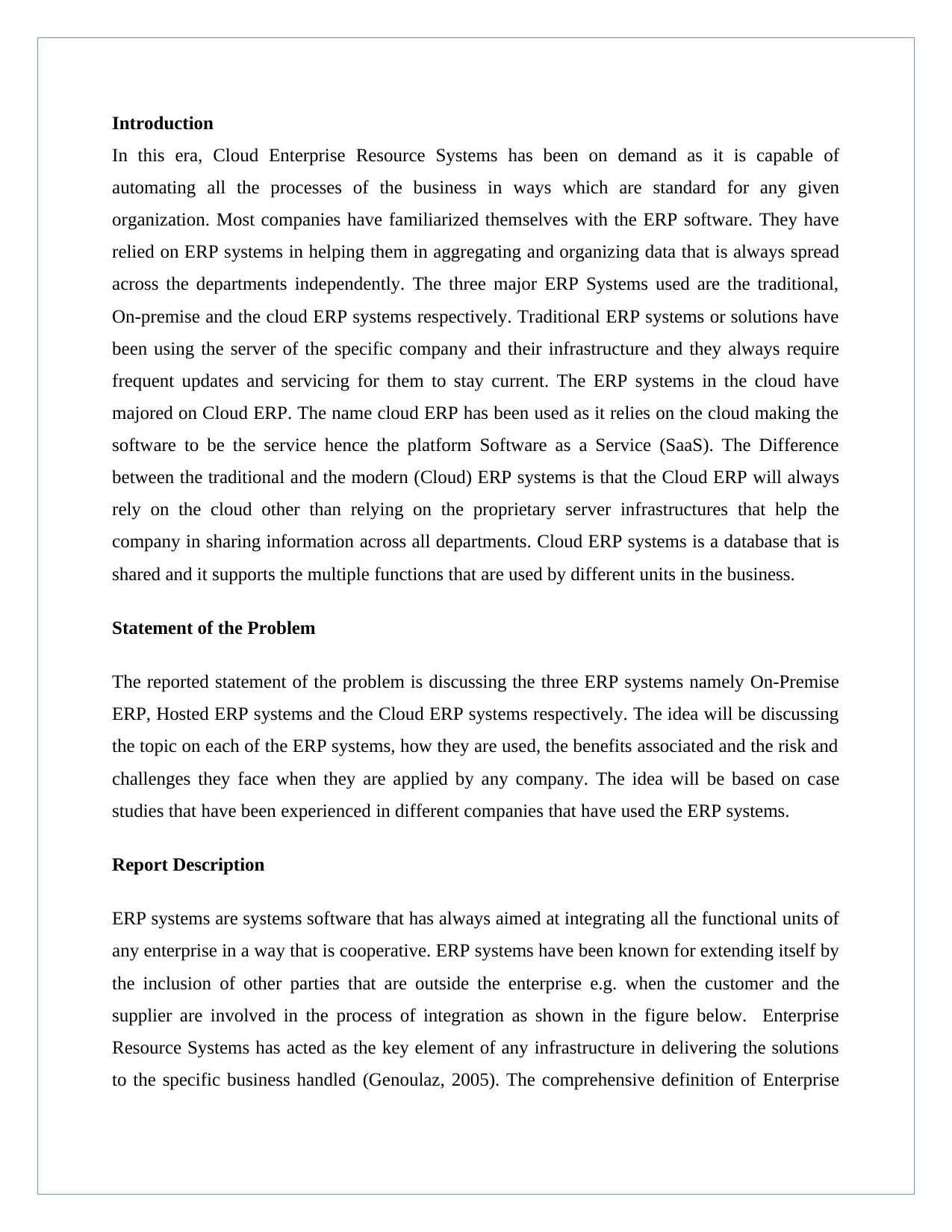
Introduction
In this era, Cloud Enterprise Resource Systems has been on demand as it is capable of
automating all the processes of the business in ways which are standard for any given
organization. Most companies have familiarized themselves with the ERP software. They have
relied on ERP systems in helping them in aggregating and organizing data that is always spread
across the departments independently. The three major ERP Systems used are the traditional,
On-premise and the cloud ERP systems respectively. Traditional ERP systems or solutions have
been using the server of the specific company and their infrastructure and they always require
frequent updates and servicing for them to stay current. The ERP systems in the cloud have
majored on Cloud ERP. The name cloud ERP has been used as it relies on the cloud making the
software to be the service hence the platform Software as a Service (SaaS). The Difference
between the traditional and the modern (Cloud) ERP systems is that the Cloud ERP will always
rely on the cloud other than relying on the proprietary server infrastructures that help the
company in sharing information across all departments. Cloud ERP systems is a database that is
shared and it supports the multiple functions that are used by different units in the business.
Statement of the Problem
The reported statement of the problem is discussing the three ERP systems namely On-Premise
ERP, Hosted ERP systems and the Cloud ERP systems respectively. The idea will be discussing
the topic on each of the ERP systems, how they are used, the benefits associated and the risk and
challenges they face when they are applied by any company. The idea will be based on case
studies that have been experienced in different companies that have used the ERP systems.
Report Description
ERP systems are systems software that has always aimed at integrating all the functional units of
any enterprise in a way that is cooperative. ERP systems have been known for extending itself by
the inclusion of other parties that are outside the enterprise e.g. when the customer and the
supplier are involved in the process of integration as shown in the figure below. Enterprise
Resource Systems has acted as the key element of any infrastructure in delivering the solutions
to the specific business handled (Genoulaz, 2005). The comprehensive definition of Enterprise
In this era, Cloud Enterprise Resource Systems has been on demand as it is capable of
automating all the processes of the business in ways which are standard for any given
organization. Most companies have familiarized themselves with the ERP software. They have
relied on ERP systems in helping them in aggregating and organizing data that is always spread
across the departments independently. The three major ERP Systems used are the traditional,
On-premise and the cloud ERP systems respectively. Traditional ERP systems or solutions have
been using the server of the specific company and their infrastructure and they always require
frequent updates and servicing for them to stay current. The ERP systems in the cloud have
majored on Cloud ERP. The name cloud ERP has been used as it relies on the cloud making the
software to be the service hence the platform Software as a Service (SaaS). The Difference
between the traditional and the modern (Cloud) ERP systems is that the Cloud ERP will always
rely on the cloud other than relying on the proprietary server infrastructures that help the
company in sharing information across all departments. Cloud ERP systems is a database that is
shared and it supports the multiple functions that are used by different units in the business.
Statement of the Problem
The reported statement of the problem is discussing the three ERP systems namely On-Premise
ERP, Hosted ERP systems and the Cloud ERP systems respectively. The idea will be discussing
the topic on each of the ERP systems, how they are used, the benefits associated and the risk and
challenges they face when they are applied by any company. The idea will be based on case
studies that have been experienced in different companies that have used the ERP systems.
Report Description
ERP systems are systems software that has always aimed at integrating all the functional units of
any enterprise in a way that is cooperative. ERP systems have been known for extending itself by
the inclusion of other parties that are outside the enterprise e.g. when the customer and the
supplier are involved in the process of integration as shown in the figure below. Enterprise
Resource Systems has acted as the key element of any infrastructure in delivering the solutions
to the specific business handled (Genoulaz, 2005). The comprehensive definition of Enterprise
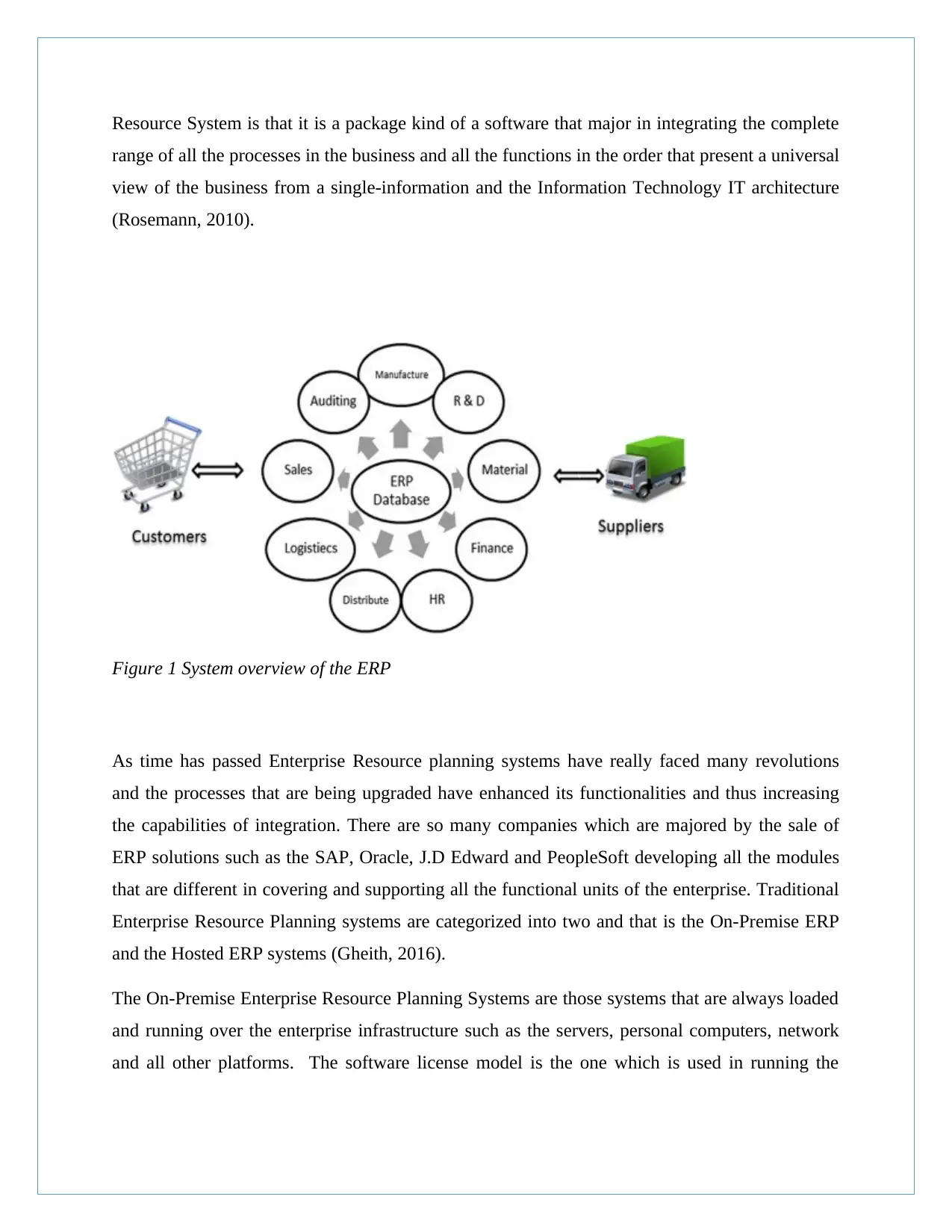
Resource System is that it is a package kind of a software that major in integrating the complete
range of all the processes in the business and all the functions in the order that present a universal
view of the business from a single-information and the Information Technology IT architecture
(Rosemann, 2010).
Figure 1 System overview of the ERP
As time has passed Enterprise Resource planning systems have really faced many revolutions
and the processes that are being upgraded have enhanced its functionalities and thus increasing
the capabilities of integration. There are so many companies which are majored by the sale of
ERP solutions such as the SAP, Oracle, J.D Edward and PeopleSoft developing all the modules
that are different in covering and supporting all the functional units of the enterprise. Traditional
Enterprise Resource Planning systems are categorized into two and that is the On-Premise ERP
and the Hosted ERP systems (Gheith, 2016).
The On-Premise Enterprise Resource Planning Systems are those systems that are always loaded
and running over the enterprise infrastructure such as the servers, personal computers, network
and all other platforms. The software license model is the one which is used in running the
range of all the processes in the business and all the functions in the order that present a universal
view of the business from a single-information and the Information Technology IT architecture
(Rosemann, 2010).
Figure 1 System overview of the ERP
As time has passed Enterprise Resource planning systems have really faced many revolutions
and the processes that are being upgraded have enhanced its functionalities and thus increasing
the capabilities of integration. There are so many companies which are majored by the sale of
ERP solutions such as the SAP, Oracle, J.D Edward and PeopleSoft developing all the modules
that are different in covering and supporting all the functional units of the enterprise. Traditional
Enterprise Resource Planning systems are categorized into two and that is the On-Premise ERP
and the Hosted ERP systems (Gheith, 2016).
The On-Premise Enterprise Resource Planning Systems are those systems that are always loaded
and running over the enterprise infrastructure such as the servers, personal computers, network
and all other platforms. The software license model is the one which is used in running the
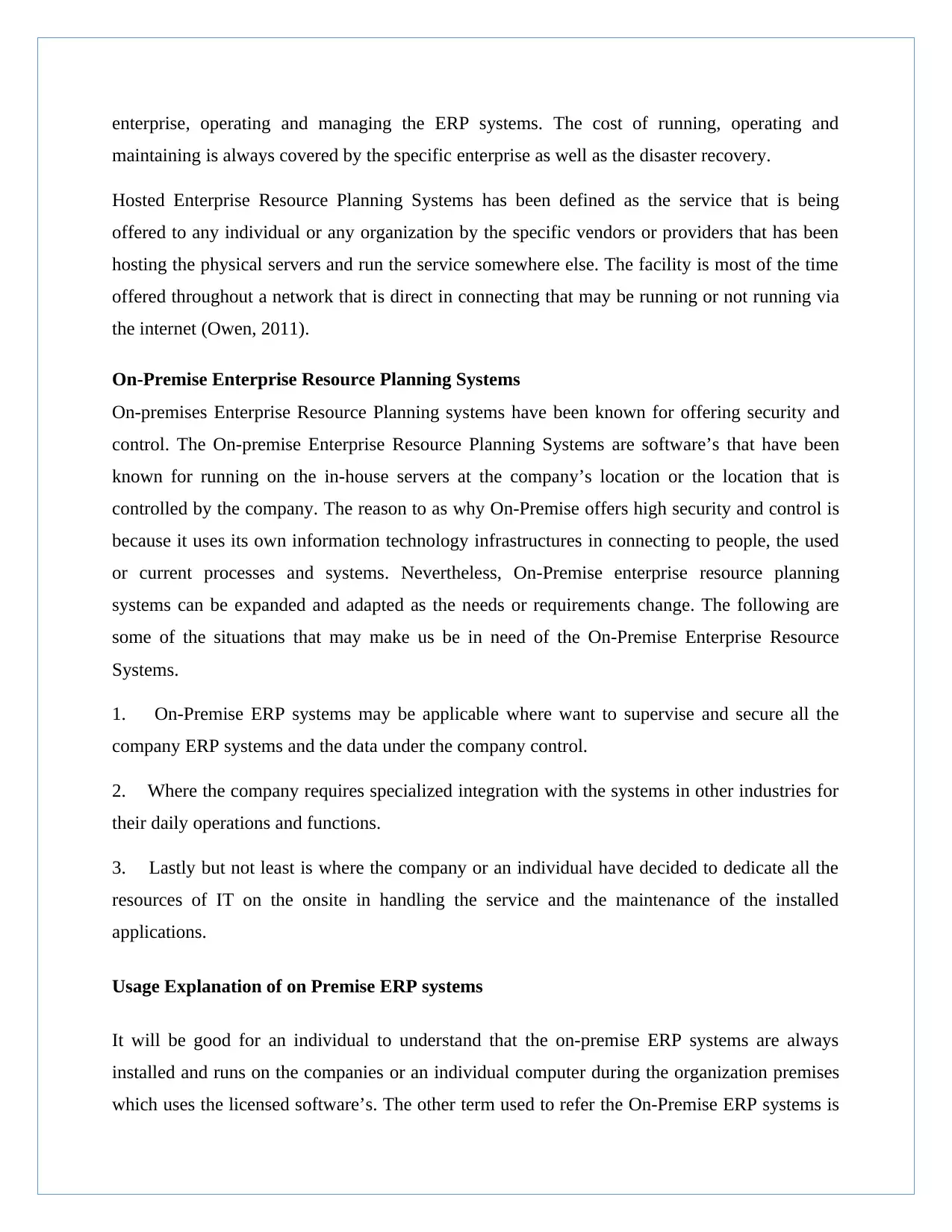
enterprise, operating and managing the ERP systems. The cost of running, operating and
maintaining is always covered by the specific enterprise as well as the disaster recovery.
Hosted Enterprise Resource Planning Systems has been defined as the service that is being
offered to any individual or any organization by the specific vendors or providers that has been
hosting the physical servers and run the service somewhere else. The facility is most of the time
offered throughout a network that is direct in connecting that may be running or not running via
the internet (Owen, 2011).
On-Premise Enterprise Resource Planning Systems
On-premises Enterprise Resource Planning systems have been known for offering security and
control. The On-premise Enterprise Resource Planning Systems are software’s that have been
known for running on the in-house servers at the company’s location or the location that is
controlled by the company. The reason to as why On-Premise offers high security and control is
because it uses its own information technology infrastructures in connecting to people, the used
or current processes and systems. Nevertheless, On-Premise enterprise resource planning
systems can be expanded and adapted as the needs or requirements change. The following are
some of the situations that may make us be in need of the On-Premise Enterprise Resource
Systems.
1. On-Premise ERP systems may be applicable where want to supervise and secure all the
company ERP systems and the data under the company control.
2. Where the company requires specialized integration with the systems in other industries for
their daily operations and functions.
3. Lastly but not least is where the company or an individual have decided to dedicate all the
resources of IT on the onsite in handling the service and the maintenance of the installed
applications.
Usage Explanation of on Premise ERP systems
It will be good for an individual to understand that the on-premise ERP systems are always
installed and runs on the companies or an individual computer during the organization premises
which uses the licensed software’s. The other term used to refer the On-Premise ERP systems is
maintaining is always covered by the specific enterprise as well as the disaster recovery.
Hosted Enterprise Resource Planning Systems has been defined as the service that is being
offered to any individual or any organization by the specific vendors or providers that has been
hosting the physical servers and run the service somewhere else. The facility is most of the time
offered throughout a network that is direct in connecting that may be running or not running via
the internet (Owen, 2011).
On-Premise Enterprise Resource Planning Systems
On-premises Enterprise Resource Planning systems have been known for offering security and
control. The On-premise Enterprise Resource Planning Systems are software’s that have been
known for running on the in-house servers at the company’s location or the location that is
controlled by the company. The reason to as why On-Premise offers high security and control is
because it uses its own information technology infrastructures in connecting to people, the used
or current processes and systems. Nevertheless, On-Premise enterprise resource planning
systems can be expanded and adapted as the needs or requirements change. The following are
some of the situations that may make us be in need of the On-Premise Enterprise Resource
Systems.
1. On-Premise ERP systems may be applicable where want to supervise and secure all the
company ERP systems and the data under the company control.
2. Where the company requires specialized integration with the systems in other industries for
their daily operations and functions.
3. Lastly but not least is where the company or an individual have decided to dedicate all the
resources of IT on the onsite in handling the service and the maintenance of the installed
applications.
Usage Explanation of on Premise ERP systems
It will be good for an individual to understand that the on-premise ERP systems are always
installed and runs on the companies or an individual computer during the organization premises
which uses the licensed software’s. The other term used to refer the On-Premise ERP systems is
Secure Best Marks with AI Grader
Need help grading? Try our AI Grader for instant feedback on your assignments.
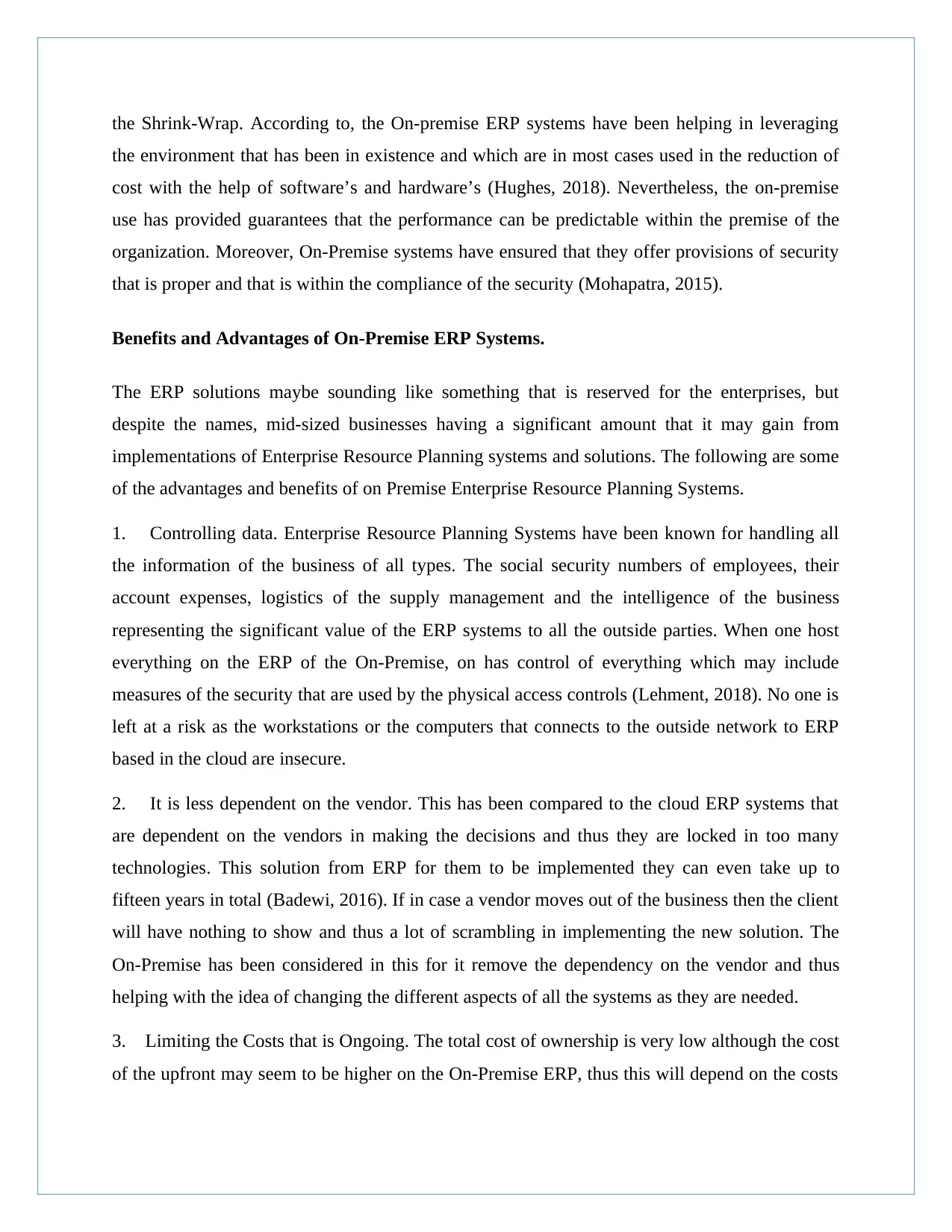
the Shrink-Wrap. According to, the On-premise ERP systems have been helping in leveraging
the environment that has been in existence and which are in most cases used in the reduction of
cost with the help of software’s and hardware’s (Hughes, 2018). Nevertheless, the on-premise
use has provided guarantees that the performance can be predictable within the premise of the
organization. Moreover, On-Premise systems have ensured that they offer provisions of security
that is proper and that is within the compliance of the security (Mohapatra, 2015).
Benefits and Advantages of On-Premise ERP Systems.
The ERP solutions maybe sounding like something that is reserved for the enterprises, but
despite the names, mid-sized businesses having a significant amount that it may gain from
implementations of Enterprise Resource Planning systems and solutions. The following are some
of the advantages and benefits of on Premise Enterprise Resource Planning Systems.
1. Controlling data. Enterprise Resource Planning Systems have been known for handling all
the information of the business of all types. The social security numbers of employees, their
account expenses, logistics of the supply management and the intelligence of the business
representing the significant value of the ERP systems to all the outside parties. When one host
everything on the ERP of the On-Premise, on has control of everything which may include
measures of the security that are used by the physical access controls (Lehment, 2018). No one is
left at a risk as the workstations or the computers that connects to the outside network to ERP
based in the cloud are insecure.
2. It is less dependent on the vendor. This has been compared to the cloud ERP systems that
are dependent on the vendors in making the decisions and thus they are locked in too many
technologies. This solution from ERP for them to be implemented they can even take up to
fifteen years in total (Badewi, 2016). If in case a vendor moves out of the business then the client
will have nothing to show and thus a lot of scrambling in implementing the new solution. The
On-Premise has been considered in this for it remove the dependency on the vendor and thus
helping with the idea of changing the different aspects of all the systems as they are needed.
3. Limiting the Costs that is Ongoing. The total cost of ownership is very low although the cost
of the upfront may seem to be higher on the On-Premise ERP, thus this will depend on the costs
the environment that has been in existence and which are in most cases used in the reduction of
cost with the help of software’s and hardware’s (Hughes, 2018). Nevertheless, the on-premise
use has provided guarantees that the performance can be predictable within the premise of the
organization. Moreover, On-Premise systems have ensured that they offer provisions of security
that is proper and that is within the compliance of the security (Mohapatra, 2015).
Benefits and Advantages of On-Premise ERP Systems.
The ERP solutions maybe sounding like something that is reserved for the enterprises, but
despite the names, mid-sized businesses having a significant amount that it may gain from
implementations of Enterprise Resource Planning systems and solutions. The following are some
of the advantages and benefits of on Premise Enterprise Resource Planning Systems.
1. Controlling data. Enterprise Resource Planning Systems have been known for handling all
the information of the business of all types. The social security numbers of employees, their
account expenses, logistics of the supply management and the intelligence of the business
representing the significant value of the ERP systems to all the outside parties. When one host
everything on the ERP of the On-Premise, on has control of everything which may include
measures of the security that are used by the physical access controls (Lehment, 2018). No one is
left at a risk as the workstations or the computers that connects to the outside network to ERP
based in the cloud are insecure.
2. It is less dependent on the vendor. This has been compared to the cloud ERP systems that
are dependent on the vendors in making the decisions and thus they are locked in too many
technologies. This solution from ERP for them to be implemented they can even take up to
fifteen years in total (Badewi, 2016). If in case a vendor moves out of the business then the client
will have nothing to show and thus a lot of scrambling in implementing the new solution. The
On-Premise has been considered in this for it remove the dependency on the vendor and thus
helping with the idea of changing the different aspects of all the systems as they are needed.
3. Limiting the Costs that is Ongoing. The total cost of ownership is very low although the cost
of the upfront may seem to be higher on the On-Premise ERP, thus this will depend on the costs
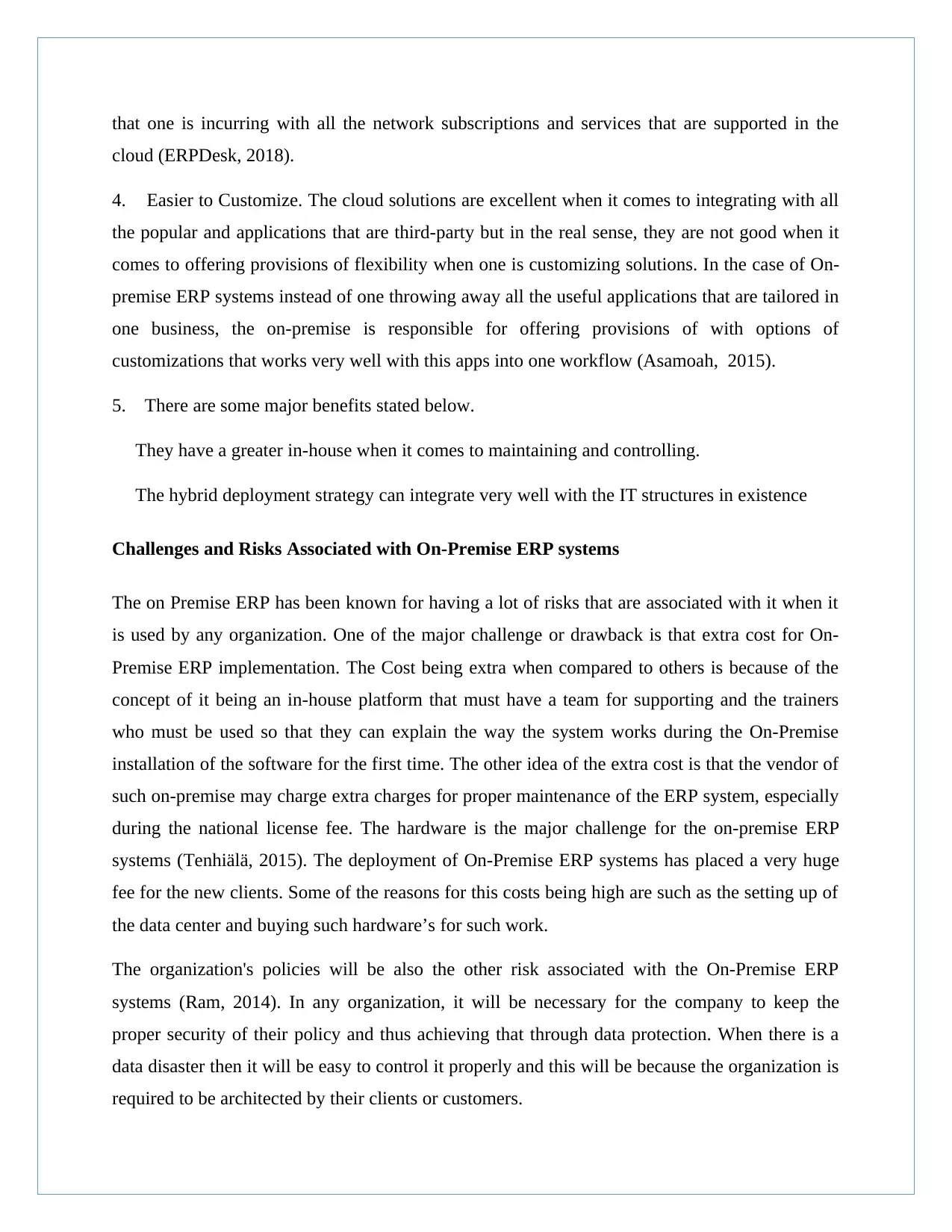
that one is incurring with all the network subscriptions and services that are supported in the
cloud (ERPDesk, 2018).
4. Easier to Customize. The cloud solutions are excellent when it comes to integrating with all
the popular and applications that are third-party but in the real sense, they are not good when it
comes to offering provisions of flexibility when one is customizing solutions. In the case of On-
premise ERP systems instead of one throwing away all the useful applications that are tailored in
one business, the on-premise is responsible for offering provisions of with options of
customizations that works very well with this apps into one workflow (Asamoah, 2015).
5. There are some major benefits stated below.
They have a greater in-house when it comes to maintaining and controlling.
The hybrid deployment strategy can integrate very well with the IT structures in existence
Challenges and Risks Associated with On-Premise ERP systems
The on Premise ERP has been known for having a lot of risks that are associated with it when it
is used by any organization. One of the major challenge or drawback is that extra cost for On-
Premise ERP implementation. The Cost being extra when compared to others is because of the
concept of it being an in-house platform that must have a team for supporting and the trainers
who must be used so that they can explain the way the system works during the On-Premise
installation of the software for the first time. The other idea of the extra cost is that the vendor of
such on-premise may charge extra charges for proper maintenance of the ERP system, especially
during the national license fee. The hardware is the major challenge for the on-premise ERP
systems (Tenhiälä, 2015). The deployment of On-Premise ERP systems has placed a very huge
fee for the new clients. Some of the reasons for this costs being high are such as the setting up of
the data center and buying such hardware’s for such work.
The organization's policies will be also the other risk associated with the On-Premise ERP
systems (Ram, 2014). In any organization, it will be necessary for the company to keep the
proper security of their policy and thus achieving that through data protection. When there is a
data disaster then it will be easy to control it properly and this will be because the organization is
required to be architected by their clients or customers.
cloud (ERPDesk, 2018).
4. Easier to Customize. The cloud solutions are excellent when it comes to integrating with all
the popular and applications that are third-party but in the real sense, they are not good when it
comes to offering provisions of flexibility when one is customizing solutions. In the case of On-
premise ERP systems instead of one throwing away all the useful applications that are tailored in
one business, the on-premise is responsible for offering provisions of with options of
customizations that works very well with this apps into one workflow (Asamoah, 2015).
5. There are some major benefits stated below.
They have a greater in-house when it comes to maintaining and controlling.
The hybrid deployment strategy can integrate very well with the IT structures in existence
Challenges and Risks Associated with On-Premise ERP systems
The on Premise ERP has been known for having a lot of risks that are associated with it when it
is used by any organization. One of the major challenge or drawback is that extra cost for On-
Premise ERP implementation. The Cost being extra when compared to others is because of the
concept of it being an in-house platform that must have a team for supporting and the trainers
who must be used so that they can explain the way the system works during the On-Premise
installation of the software for the first time. The other idea of the extra cost is that the vendor of
such on-premise may charge extra charges for proper maintenance of the ERP system, especially
during the national license fee. The hardware is the major challenge for the on-premise ERP
systems (Tenhiälä, 2015). The deployment of On-Premise ERP systems has placed a very huge
fee for the new clients. Some of the reasons for this costs being high are such as the setting up of
the data center and buying such hardware’s for such work.
The organization's policies will be also the other risk associated with the On-Premise ERP
systems (Ram, 2014). In any organization, it will be necessary for the company to keep the
proper security of their policy and thus achieving that through data protection. When there is a
data disaster then it will be easy to control it properly and this will be because the organization is
required to be architected by their clients or customers.
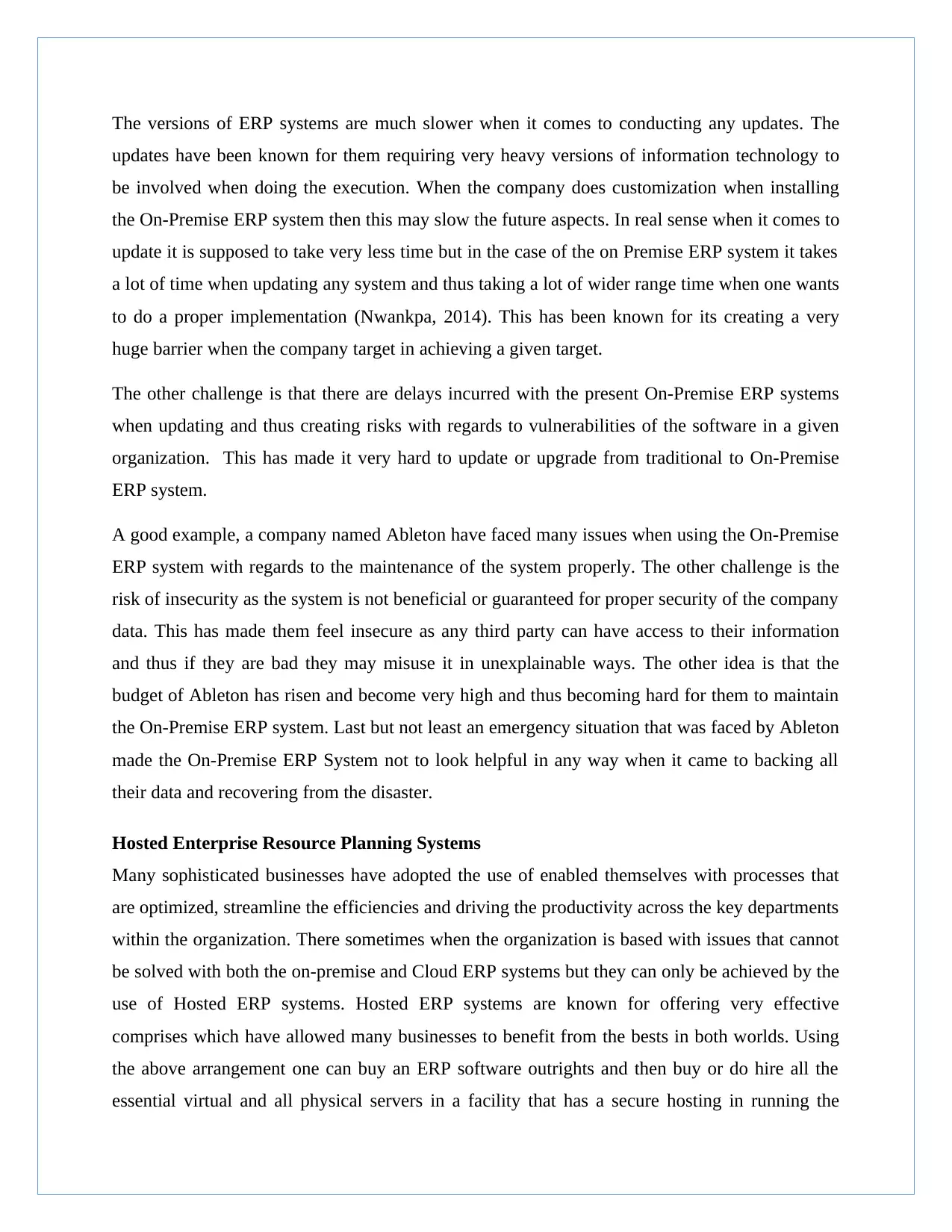
The versions of ERP systems are much slower when it comes to conducting any updates. The
updates have been known for them requiring very heavy versions of information technology to
be involved when doing the execution. When the company does customization when installing
the On-Premise ERP system then this may slow the future aspects. In real sense when it comes to
update it is supposed to take very less time but in the case of the on Premise ERP system it takes
a lot of time when updating any system and thus taking a lot of wider range time when one wants
to do a proper implementation (Nwankpa, 2014). This has been known for its creating a very
huge barrier when the company target in achieving a given target.
The other challenge is that there are delays incurred with the present On-Premise ERP systems
when updating and thus creating risks with regards to vulnerabilities of the software in a given
organization. This has made it very hard to update or upgrade from traditional to On-Premise
ERP system.
A good example, a company named Ableton have faced many issues when using the On-Premise
ERP system with regards to the maintenance of the system properly. The other challenge is the
risk of insecurity as the system is not beneficial or guaranteed for proper security of the company
data. This has made them feel insecure as any third party can have access to their information
and thus if they are bad they may misuse it in unexplainable ways. The other idea is that the
budget of Ableton has risen and become very high and thus becoming hard for them to maintain
the On-Premise ERP system. Last but not least an emergency situation that was faced by Ableton
made the On-Premise ERP System not to look helpful in any way when it came to backing all
their data and recovering from the disaster.
Hosted Enterprise Resource Planning Systems
Many sophisticated businesses have adopted the use of enabled themselves with processes that
are optimized, streamline the efficiencies and driving the productivity across the key departments
within the organization. There sometimes when the organization is based with issues that cannot
be solved with both the on-premise and Cloud ERP systems but they can only be achieved by the
use of Hosted ERP systems. Hosted ERP systems are known for offering very effective
comprises which have allowed many businesses to benefit from the bests in both worlds. Using
the above arrangement one can buy an ERP software outrights and then buy or do hire all the
essential virtual and all physical servers in a facility that has a secure hosting in running the
updates have been known for them requiring very heavy versions of information technology to
be involved when doing the execution. When the company does customization when installing
the On-Premise ERP system then this may slow the future aspects. In real sense when it comes to
update it is supposed to take very less time but in the case of the on Premise ERP system it takes
a lot of time when updating any system and thus taking a lot of wider range time when one wants
to do a proper implementation (Nwankpa, 2014). This has been known for its creating a very
huge barrier when the company target in achieving a given target.
The other challenge is that there are delays incurred with the present On-Premise ERP systems
when updating and thus creating risks with regards to vulnerabilities of the software in a given
organization. This has made it very hard to update or upgrade from traditional to On-Premise
ERP system.
A good example, a company named Ableton have faced many issues when using the On-Premise
ERP system with regards to the maintenance of the system properly. The other challenge is the
risk of insecurity as the system is not beneficial or guaranteed for proper security of the company
data. This has made them feel insecure as any third party can have access to their information
and thus if they are bad they may misuse it in unexplainable ways. The other idea is that the
budget of Ableton has risen and become very high and thus becoming hard for them to maintain
the On-Premise ERP system. Last but not least an emergency situation that was faced by Ableton
made the On-Premise ERP System not to look helpful in any way when it came to backing all
their data and recovering from the disaster.
Hosted Enterprise Resource Planning Systems
Many sophisticated businesses have adopted the use of enabled themselves with processes that
are optimized, streamline the efficiencies and driving the productivity across the key departments
within the organization. There sometimes when the organization is based with issues that cannot
be solved with both the on-premise and Cloud ERP systems but they can only be achieved by the
use of Hosted ERP systems. Hosted ERP systems are known for offering very effective
comprises which have allowed many businesses to benefit from the bests in both worlds. Using
the above arrangement one can buy an ERP software outrights and then buy or do hire all the
essential virtual and all physical servers in a facility that has a secure hosting in running the
Paraphrase This Document
Need a fresh take? Get an instant paraphrase of this document with our AI Paraphraser
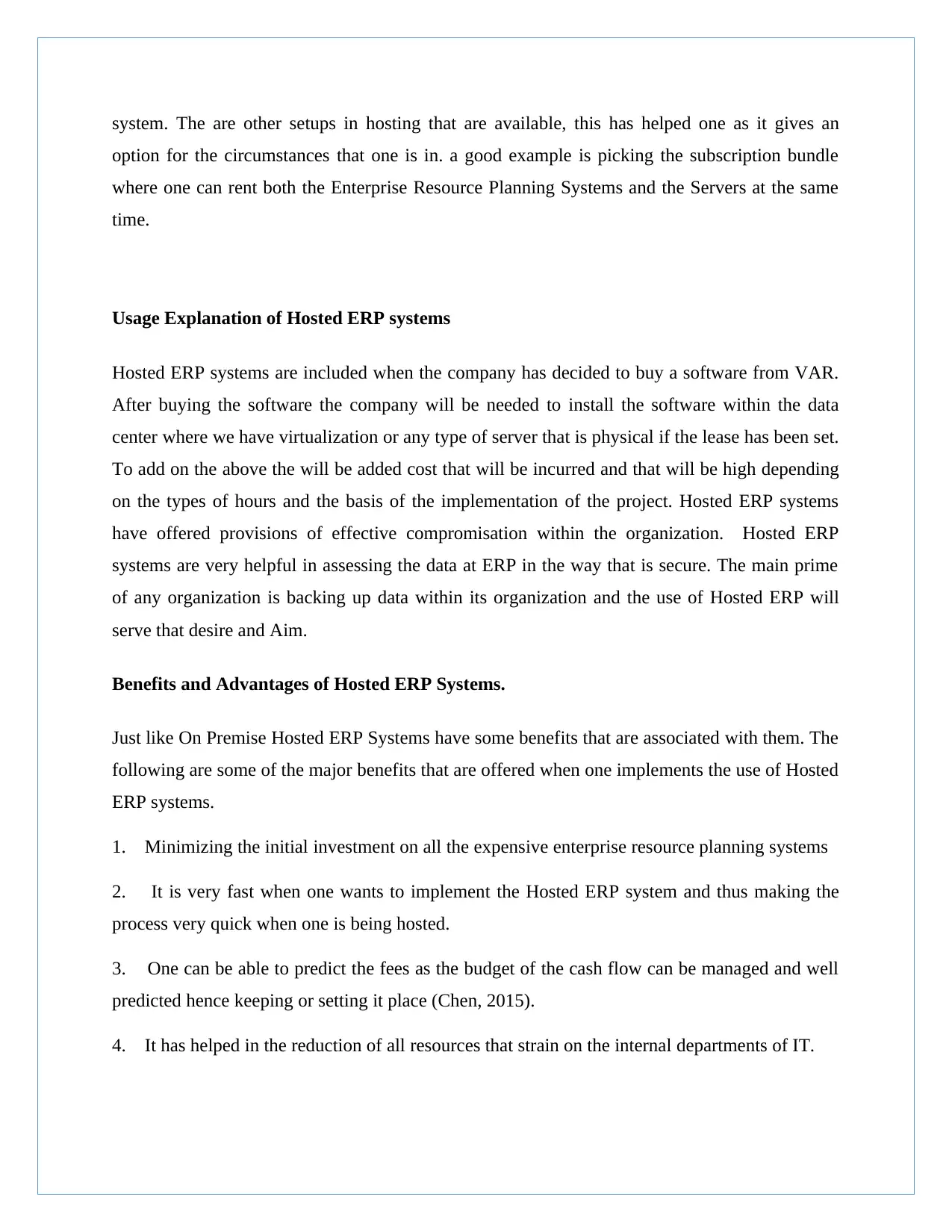
system. The are other setups in hosting that are available, this has helped one as it gives an
option for the circumstances that one is in. a good example is picking the subscription bundle
where one can rent both the Enterprise Resource Planning Systems and the Servers at the same
time.
Usage Explanation of Hosted ERP systems
Hosted ERP systems are included when the company has decided to buy a software from VAR.
After buying the software the company will be needed to install the software within the data
center where we have virtualization or any type of server that is physical if the lease has been set.
To add on the above the will be added cost that will be incurred and that will be high depending
on the types of hours and the basis of the implementation of the project. Hosted ERP systems
have offered provisions of effective compromisation within the organization. Hosted ERP
systems are very helpful in assessing the data at ERP in the way that is secure. The main prime
of any organization is backing up data within its organization and the use of Hosted ERP will
serve that desire and Aim.
Benefits and Advantages of Hosted ERP Systems.
Just like On Premise Hosted ERP Systems have some benefits that are associated with them. The
following are some of the major benefits that are offered when one implements the use of Hosted
ERP systems.
1. Minimizing the initial investment on all the expensive enterprise resource planning systems
2. It is very fast when one wants to implement the Hosted ERP system and thus making the
process very quick when one is being hosted.
3. One can be able to predict the fees as the budget of the cash flow can be managed and well
predicted hence keeping or setting it place (Chen, 2015).
4. It has helped in the reduction of all resources that strain on the internal departments of IT.
option for the circumstances that one is in. a good example is picking the subscription bundle
where one can rent both the Enterprise Resource Planning Systems and the Servers at the same
time.
Usage Explanation of Hosted ERP systems
Hosted ERP systems are included when the company has decided to buy a software from VAR.
After buying the software the company will be needed to install the software within the data
center where we have virtualization or any type of server that is physical if the lease has been set.
To add on the above the will be added cost that will be incurred and that will be high depending
on the types of hours and the basis of the implementation of the project. Hosted ERP systems
have offered provisions of effective compromisation within the organization. Hosted ERP
systems are very helpful in assessing the data at ERP in the way that is secure. The main prime
of any organization is backing up data within its organization and the use of Hosted ERP will
serve that desire and Aim.
Benefits and Advantages of Hosted ERP Systems.
Just like On Premise Hosted ERP Systems have some benefits that are associated with them. The
following are some of the major benefits that are offered when one implements the use of Hosted
ERP systems.
1. Minimizing the initial investment on all the expensive enterprise resource planning systems
2. It is very fast when one wants to implement the Hosted ERP system and thus making the
process very quick when one is being hosted.
3. One can be able to predict the fees as the budget of the cash flow can be managed and well
predicted hence keeping or setting it place (Chen, 2015).
4. It has helped in the reduction of all resources that strain on the internal departments of IT.
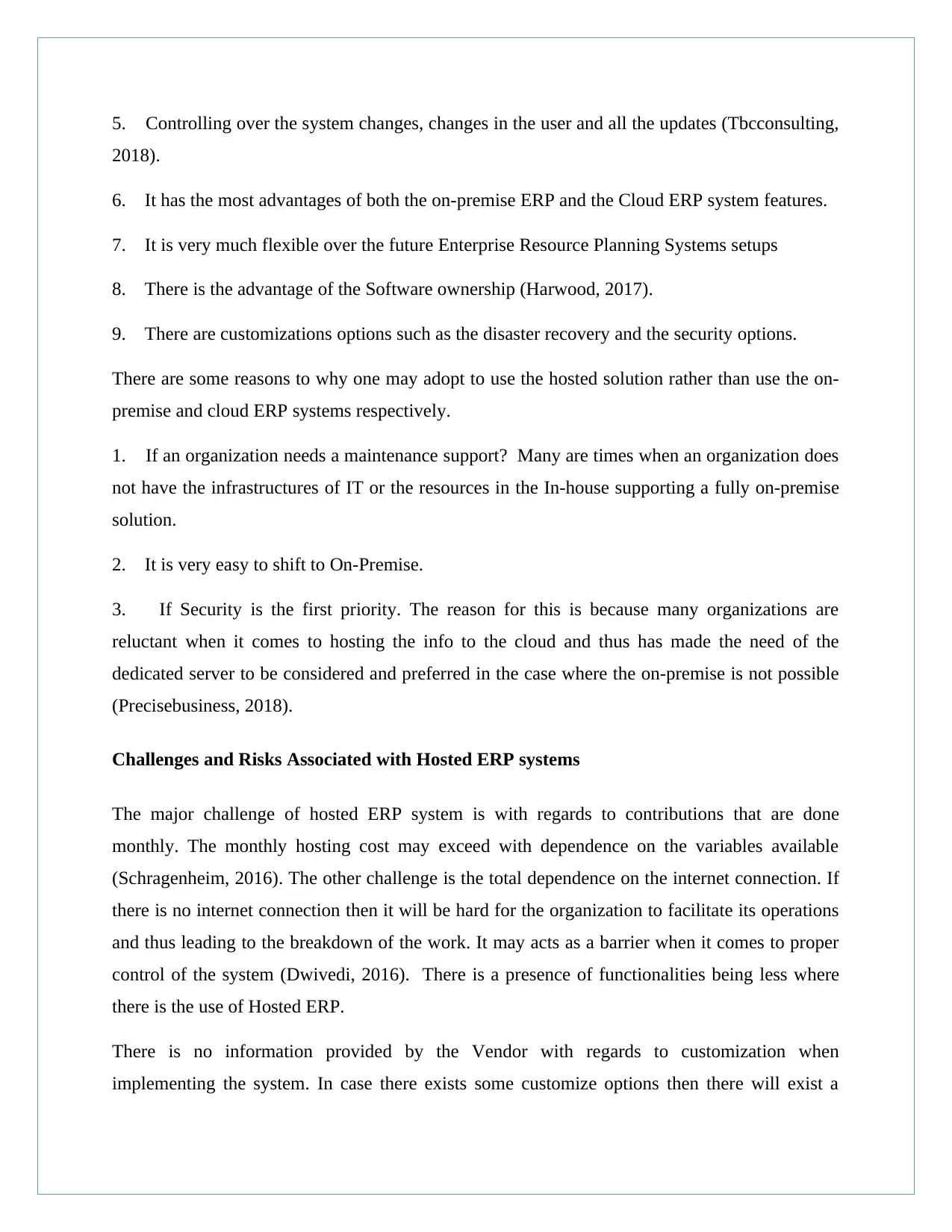
5. Controlling over the system changes, changes in the user and all the updates (Tbcconsulting,
2018).
6. It has the most advantages of both the on-premise ERP and the Cloud ERP system features.
7. It is very much flexible over the future Enterprise Resource Planning Systems setups
8. There is the advantage of the Software ownership (Harwood, 2017).
9. There are customizations options such as the disaster recovery and the security options.
There are some reasons to why one may adopt to use the hosted solution rather than use the on-
premise and cloud ERP systems respectively.
1. If an organization needs a maintenance support? Many are times when an organization does
not have the infrastructures of IT or the resources in the In-house supporting a fully on-premise
solution.
2. It is very easy to shift to On-Premise.
3. If Security is the first priority. The reason for this is because many organizations are
reluctant when it comes to hosting the info to the cloud and thus has made the need of the
dedicated server to be considered and preferred in the case where the on-premise is not possible
(Precisebusiness, 2018).
Challenges and Risks Associated with Hosted ERP systems
The major challenge of hosted ERP system is with regards to contributions that are done
monthly. The monthly hosting cost may exceed with dependence on the variables available
(Schragenheim, 2016). The other challenge is the total dependence on the internet connection. If
there is no internet connection then it will be hard for the organization to facilitate its operations
and thus leading to the breakdown of the work. It may acts as a barrier when it comes to proper
control of the system (Dwivedi, 2016). There is a presence of functionalities being less where
there is the use of Hosted ERP.
There is no information provided by the Vendor with regards to customization when
implementing the system. In case there exists some customize options then there will exist a
2018).
6. It has the most advantages of both the on-premise ERP and the Cloud ERP system features.
7. It is very much flexible over the future Enterprise Resource Planning Systems setups
8. There is the advantage of the Software ownership (Harwood, 2017).
9. There are customizations options such as the disaster recovery and the security options.
There are some reasons to why one may adopt to use the hosted solution rather than use the on-
premise and cloud ERP systems respectively.
1. If an organization needs a maintenance support? Many are times when an organization does
not have the infrastructures of IT or the resources in the In-house supporting a fully on-premise
solution.
2. It is very easy to shift to On-Premise.
3. If Security is the first priority. The reason for this is because many organizations are
reluctant when it comes to hosting the info to the cloud and thus has made the need of the
dedicated server to be considered and preferred in the case where the on-premise is not possible
(Precisebusiness, 2018).
Challenges and Risks Associated with Hosted ERP systems
The major challenge of hosted ERP system is with regards to contributions that are done
monthly. The monthly hosting cost may exceed with dependence on the variables available
(Schragenheim, 2016). The other challenge is the total dependence on the internet connection. If
there is no internet connection then it will be hard for the organization to facilitate its operations
and thus leading to the breakdown of the work. It may acts as a barrier when it comes to proper
control of the system (Dwivedi, 2016). There is a presence of functionalities being less where
there is the use of Hosted ERP.
There is no information provided by the Vendor with regards to customization when
implementing the system. In case there exists some customize options then there will exist a
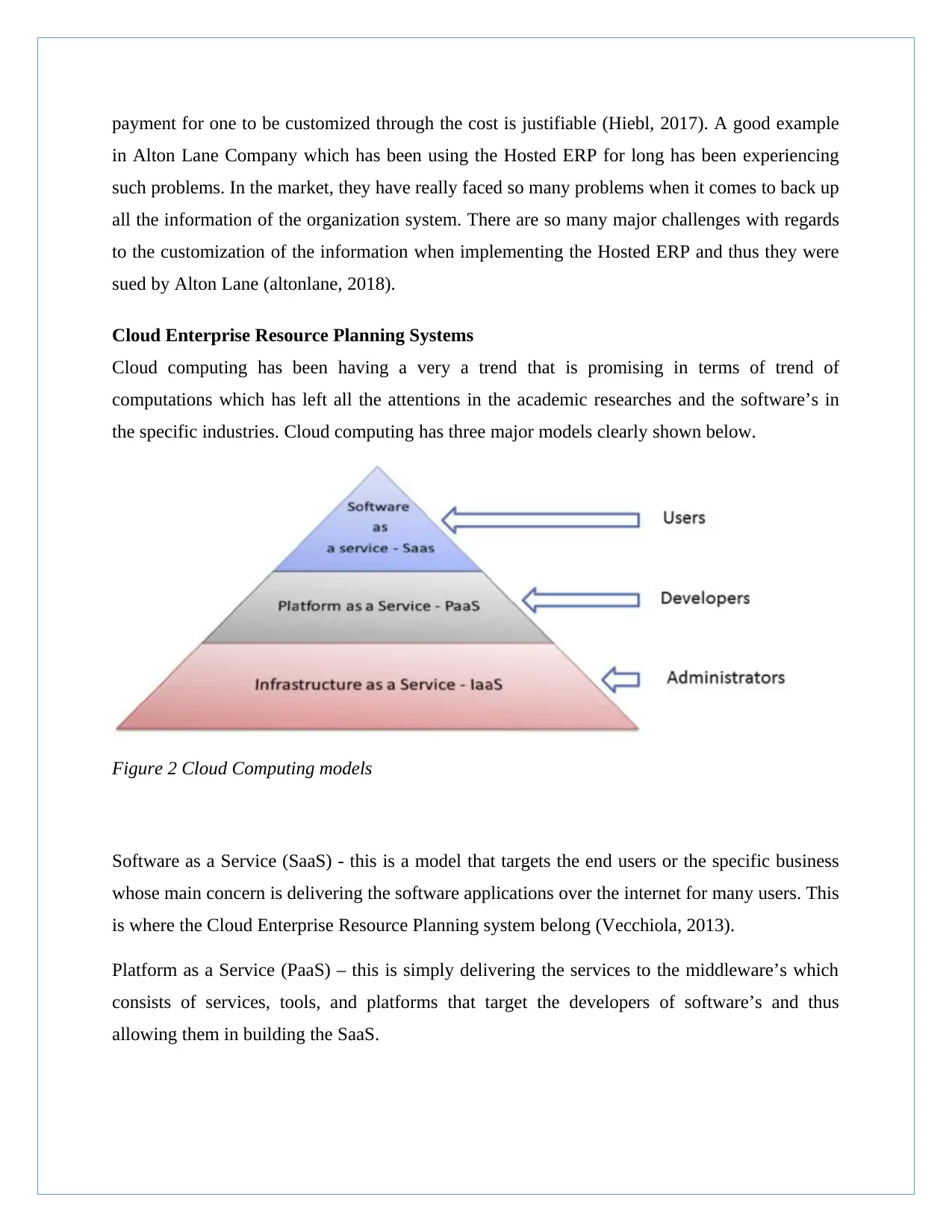
payment for one to be customized through the cost is justifiable (Hiebl, 2017). A good example
in Alton Lane Company which has been using the Hosted ERP for long has been experiencing
such problems. In the market, they have really faced so many problems when it comes to back up
all the information of the organization system. There are so many major challenges with regards
to the customization of the information when implementing the Hosted ERP and thus they were
sued by Alton Lane (altonlane, 2018).
Cloud Enterprise Resource Planning Systems
Cloud computing has been having a very a trend that is promising in terms of trend of
computations which has left all the attentions in the academic researches and the software’s in
the specific industries. Cloud computing has three major models clearly shown below.
Figure 2 Cloud Computing models
Software as a Service (SaaS) - this is a model that targets the end users or the specific business
whose main concern is delivering the software applications over the internet for many users. This
is where the Cloud Enterprise Resource Planning system belong (Vecchiola, 2013).
Platform as a Service (PaaS) – this is simply delivering the services to the middleware’s which
consists of services, tools, and platforms that target the developers of software’s and thus
allowing them in building the SaaS.
in Alton Lane Company which has been using the Hosted ERP for long has been experiencing
such problems. In the market, they have really faced so many problems when it comes to back up
all the information of the organization system. There are so many major challenges with regards
to the customization of the information when implementing the Hosted ERP and thus they were
sued by Alton Lane (altonlane, 2018).
Cloud Enterprise Resource Planning Systems
Cloud computing has been having a very a trend that is promising in terms of trend of
computations which has left all the attentions in the academic researches and the software’s in
the specific industries. Cloud computing has three major models clearly shown below.
Figure 2 Cloud Computing models
Software as a Service (SaaS) - this is a model that targets the end users or the specific business
whose main concern is delivering the software applications over the internet for many users. This
is where the Cloud Enterprise Resource Planning system belong (Vecchiola, 2013).
Platform as a Service (PaaS) – this is simply delivering the services to the middleware’s which
consists of services, tools, and platforms that target the developers of software’s and thus
allowing them in building the SaaS.
Secure Best Marks with AI Grader
Need help grading? Try our AI Grader for instant feedback on your assignments.
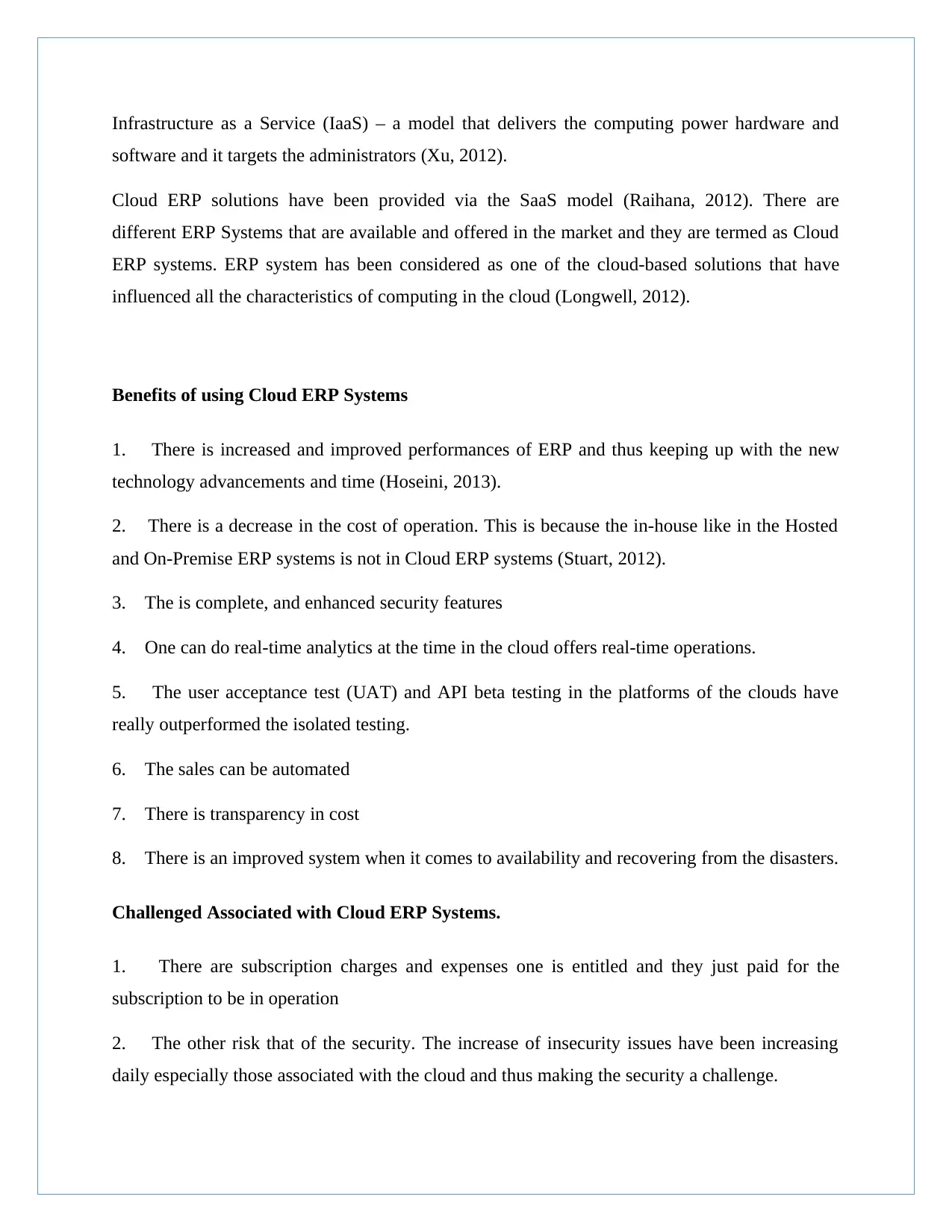
Infrastructure as a Service (IaaS) – a model that delivers the computing power hardware and
software and it targets the administrators (Xu, 2012).
Cloud ERP solutions have been provided via the SaaS model (Raihana, 2012). There are
different ERP Systems that are available and offered in the market and they are termed as Cloud
ERP systems. ERP system has been considered as one of the cloud-based solutions that have
influenced all the characteristics of computing in the cloud (Longwell, 2012).
Benefits of using Cloud ERP Systems
1. There is increased and improved performances of ERP and thus keeping up with the new
technology advancements and time (Hoseini, 2013).
2. There is a decrease in the cost of operation. This is because the in-house like in the Hosted
and On-Premise ERP systems is not in Cloud ERP systems (Stuart, 2012).
3. The is complete, and enhanced security features
4. One can do real-time analytics at the time in the cloud offers real-time operations.
5. The user acceptance test (UAT) and API beta testing in the platforms of the clouds have
really outperformed the isolated testing.
6. The sales can be automated
7. There is transparency in cost
8. There is an improved system when it comes to availability and recovering from the disasters.
Challenged Associated with Cloud ERP Systems.
1. There are subscription charges and expenses one is entitled and they just paid for the
subscription to be in operation
2. The other risk that of the security. The increase of insecurity issues have been increasing
daily especially those associated with the cloud and thus making the security a challenge.
software and it targets the administrators (Xu, 2012).
Cloud ERP solutions have been provided via the SaaS model (Raihana, 2012). There are
different ERP Systems that are available and offered in the market and they are termed as Cloud
ERP systems. ERP system has been considered as one of the cloud-based solutions that have
influenced all the characteristics of computing in the cloud (Longwell, 2012).
Benefits of using Cloud ERP Systems
1. There is increased and improved performances of ERP and thus keeping up with the new
technology advancements and time (Hoseini, 2013).
2. There is a decrease in the cost of operation. This is because the in-house like in the Hosted
and On-Premise ERP systems is not in Cloud ERP systems (Stuart, 2012).
3. The is complete, and enhanced security features
4. One can do real-time analytics at the time in the cloud offers real-time operations.
5. The user acceptance test (UAT) and API beta testing in the platforms of the clouds have
really outperformed the isolated testing.
6. The sales can be automated
7. There is transparency in cost
8. There is an improved system when it comes to availability and recovering from the disasters.
Challenged Associated with Cloud ERP Systems.
1. There are subscription charges and expenses one is entitled and they just paid for the
subscription to be in operation
2. The other risk that of the security. The increase of insecurity issues have been increasing
daily especially those associated with the cloud and thus making the security a challenge.
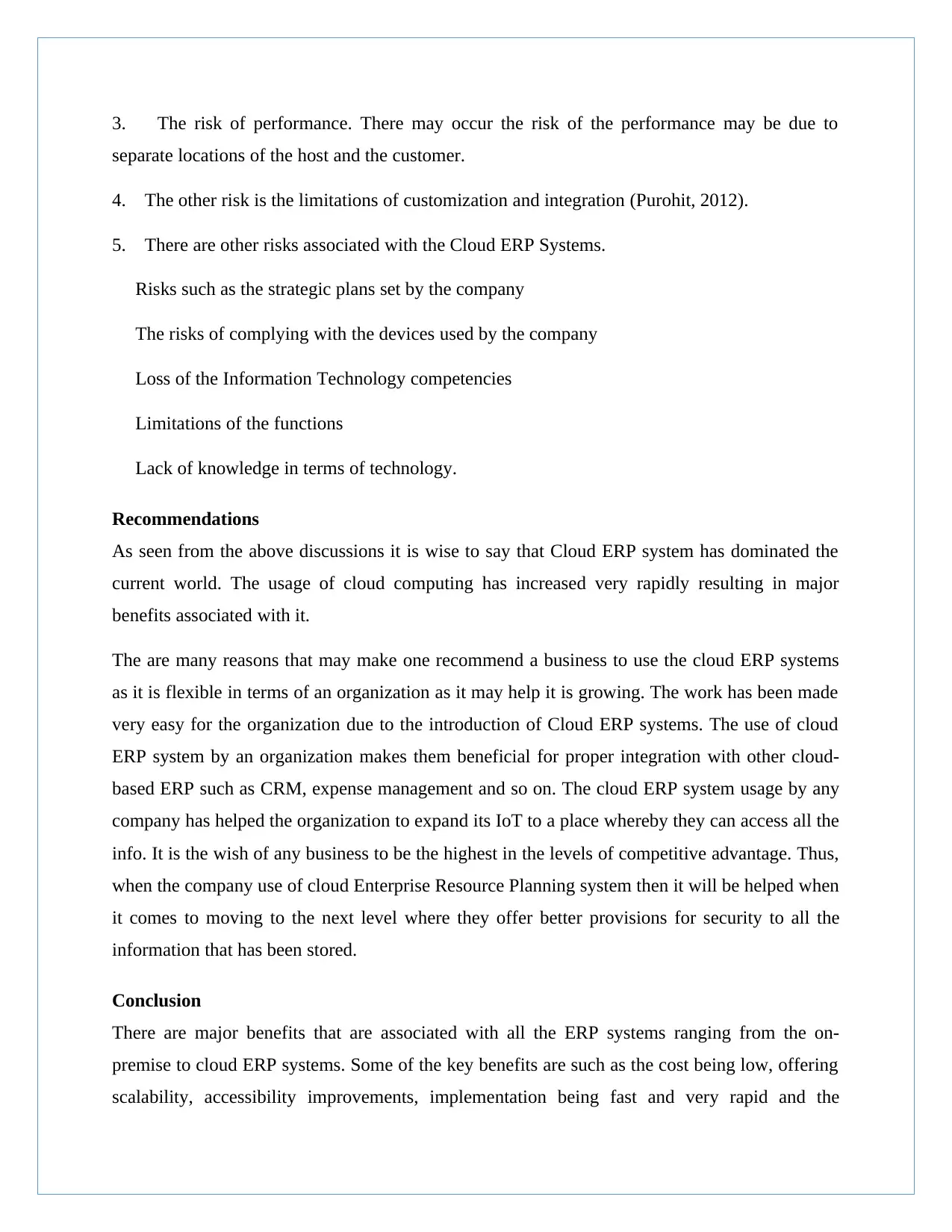
3. The risk of performance. There may occur the risk of the performance may be due to
separate locations of the host and the customer.
4. The other risk is the limitations of customization and integration (Purohit, 2012).
5. There are other risks associated with the Cloud ERP Systems.
Risks such as the strategic plans set by the company
The risks of complying with the devices used by the company
Loss of the Information Technology competencies
Limitations of the functions
Lack of knowledge in terms of technology.
Recommendations
As seen from the above discussions it is wise to say that Cloud ERP system has dominated the
current world. The usage of cloud computing has increased very rapidly resulting in major
benefits associated with it.
The are many reasons that may make one recommend a business to use the cloud ERP systems
as it is flexible in terms of an organization as it may help it is growing. The work has been made
very easy for the organization due to the introduction of Cloud ERP systems. The use of cloud
ERP system by an organization makes them beneficial for proper integration with other cloud-
based ERP such as CRM, expense management and so on. The cloud ERP system usage by any
company has helped the organization to expand its IoT to a place whereby they can access all the
info. It is the wish of any business to be the highest in the levels of competitive advantage. Thus,
when the company use of cloud Enterprise Resource Planning system then it will be helped when
it comes to moving to the next level where they offer better provisions for security to all the
information that has been stored.
Conclusion
There are major benefits that are associated with all the ERP systems ranging from the on-
premise to cloud ERP systems. Some of the key benefits are such as the cost being low, offering
scalability, accessibility improvements, implementation being fast and very rapid and the
separate locations of the host and the customer.
4. The other risk is the limitations of customization and integration (Purohit, 2012).
5. There are other risks associated with the Cloud ERP Systems.
Risks such as the strategic plans set by the company
The risks of complying with the devices used by the company
Loss of the Information Technology competencies
Limitations of the functions
Lack of knowledge in terms of technology.
Recommendations
As seen from the above discussions it is wise to say that Cloud ERP system has dominated the
current world. The usage of cloud computing has increased very rapidly resulting in major
benefits associated with it.
The are many reasons that may make one recommend a business to use the cloud ERP systems
as it is flexible in terms of an organization as it may help it is growing. The work has been made
very easy for the organization due to the introduction of Cloud ERP systems. The use of cloud
ERP system by an organization makes them beneficial for proper integration with other cloud-
based ERP such as CRM, expense management and so on. The cloud ERP system usage by any
company has helped the organization to expand its IoT to a place whereby they can access all the
info. It is the wish of any business to be the highest in the levels of competitive advantage. Thus,
when the company use of cloud Enterprise Resource Planning system then it will be helped when
it comes to moving to the next level where they offer better provisions for security to all the
information that has been stored.
Conclusion
There are major benefits that are associated with all the ERP systems ranging from the on-
premise to cloud ERP systems. Some of the key benefits are such as the cost being low, offering
scalability, accessibility improvements, implementation being fast and very rapid and the
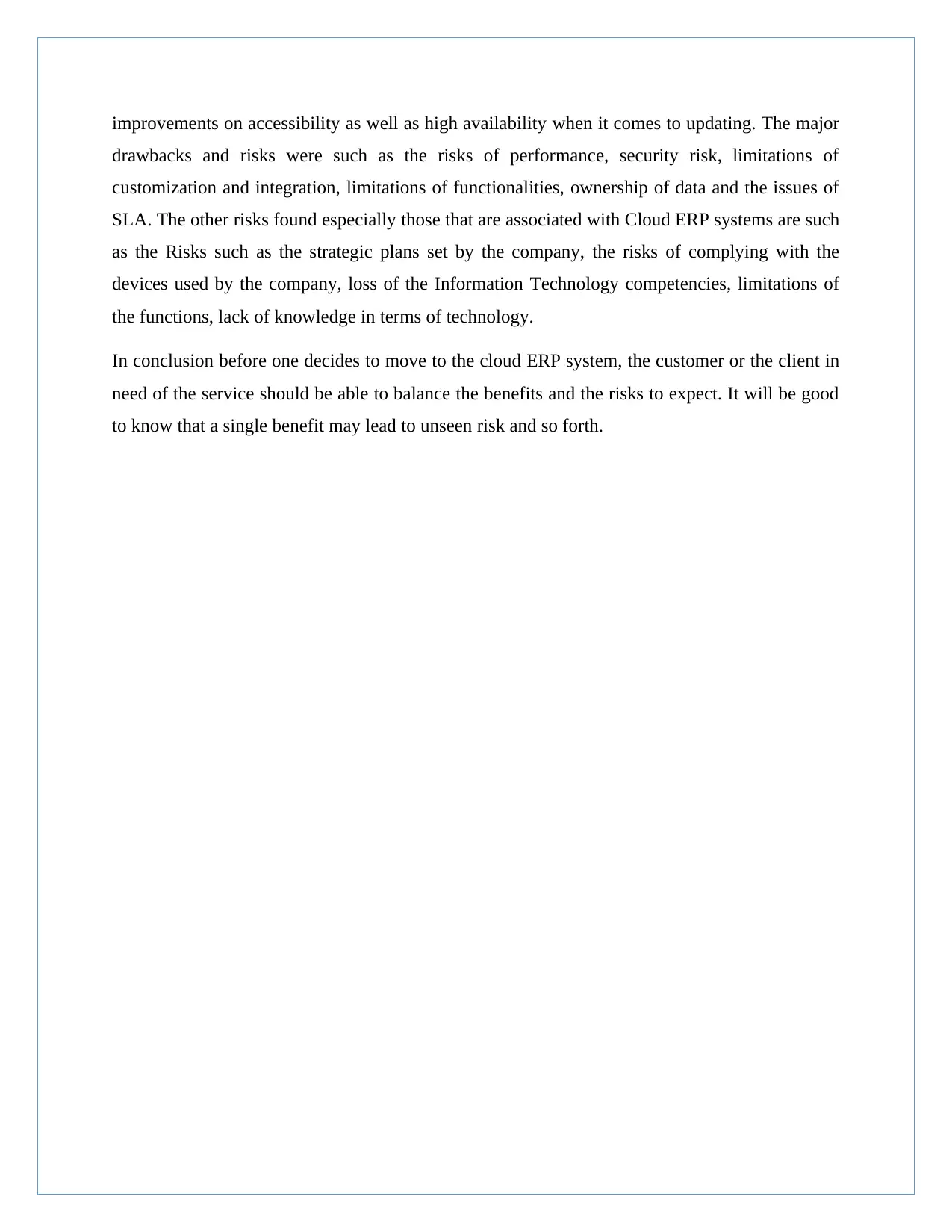
improvements on accessibility as well as high availability when it comes to updating. The major
drawbacks and risks were such as the risks of performance, security risk, limitations of
customization and integration, limitations of functionalities, ownership of data and the issues of
SLA. The other risks found especially those that are associated with Cloud ERP systems are such
as the Risks such as the strategic plans set by the company, the risks of complying with the
devices used by the company, loss of the Information Technology competencies, limitations of
the functions, lack of knowledge in terms of technology.
In conclusion before one decides to move to the cloud ERP system, the customer or the client in
need of the service should be able to balance the benefits and the risks to expect. It will be good
to know that a single benefit may lead to unseen risk and so forth.
drawbacks and risks were such as the risks of performance, security risk, limitations of
customization and integration, limitations of functionalities, ownership of data and the issues of
SLA. The other risks found especially those that are associated with Cloud ERP systems are such
as the Risks such as the strategic plans set by the company, the risks of complying with the
devices used by the company, loss of the Information Technology competencies, limitations of
the functions, lack of knowledge in terms of technology.
In conclusion before one decides to move to the cloud ERP system, the customer or the client in
need of the service should be able to balance the benefits and the risks to expect. It will be good
to know that a single benefit may lead to unseen risk and so forth.
Paraphrase This Document
Need a fresh take? Get an instant paraphrase of this document with our AI Paraphraser
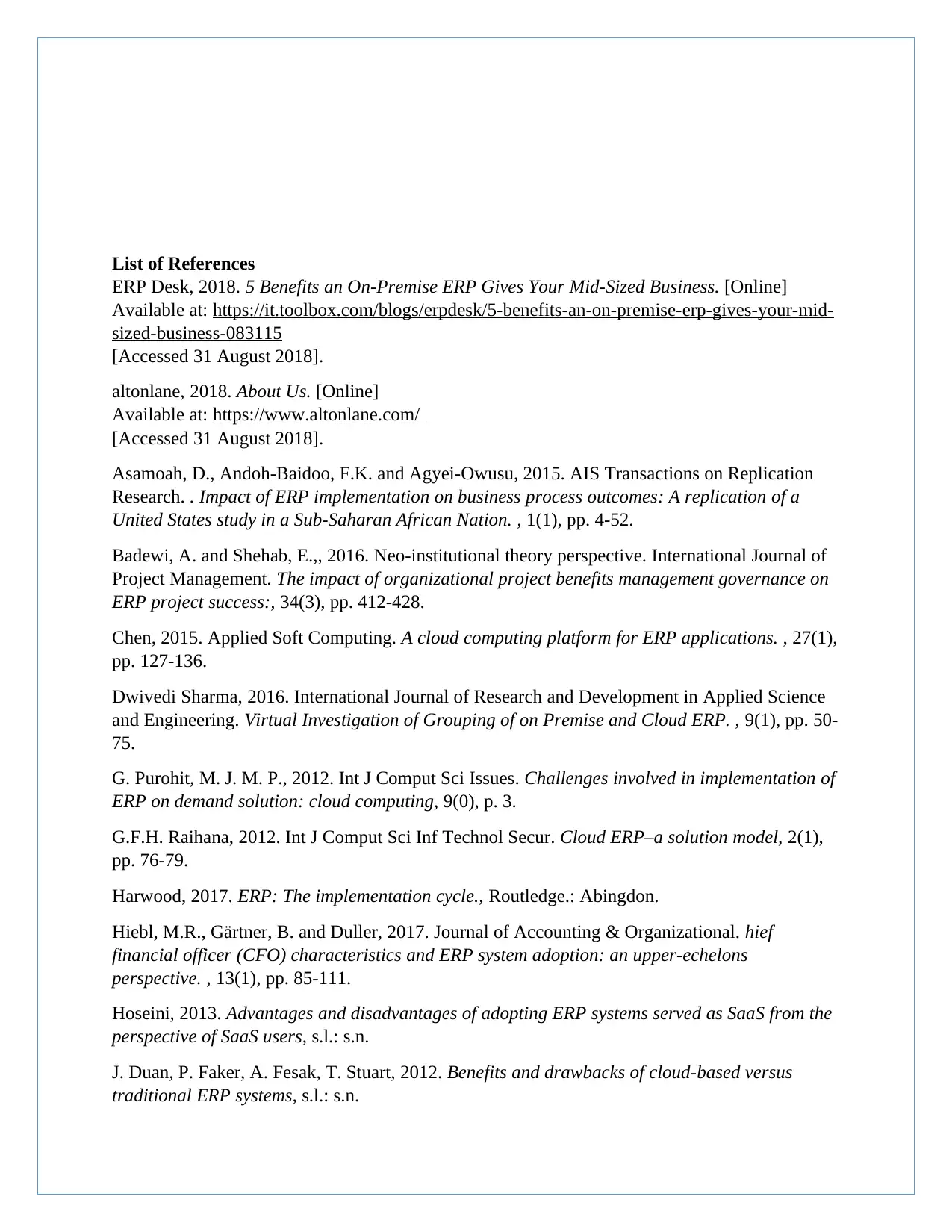
List of References
ERP Desk, 2018. 5 Benefits an On-Premise ERP Gives Your Mid-Sized Business. [Online]
Available at: https://it.toolbox.com/blogs/erpdesk/5-benefits-an-on-premise-erp-gives-your-mid-
sized-business-083115
[Accessed 31 August 2018].
altonlane, 2018. About Us. [Online]
Available at: https://www.altonlane.com/
[Accessed 31 August 2018].
Asamoah, D., Andoh-Baidoo, F.K. and Agyei-Owusu, 2015. AIS Transactions on Replication
Research. . Impact of ERP implementation on business process outcomes: A replication of a
United States study in a Sub-Saharan African Nation. , 1(1), pp. 4-52.
Badewi, A. and Shehab, E.,, 2016. Neo-institutional theory perspective. International Journal of
Project Management. The impact of organizational project benefits management governance on
ERP project success:, 34(3), pp. 412-428.
Chen, 2015. Applied Soft Computing. A cloud computing platform for ERP applications. , 27(1),
pp. 127-136.
Dwivedi Sharma, 2016. International Journal of Research and Development in Applied Science
and Engineering. Virtual Investigation of Grouping of on Premise and Cloud ERP. , 9(1), pp. 50-
75.
G. Purohit, M. J. M. P., 2012. Int J Comput Sci Issues. Challenges involved in implementation of
ERP on demand solution: cloud computing, 9(0), p. 3.
G.F.H. Raihana, 2012. Int J Comput Sci Inf Technol Secur. Cloud ERP–a solution model, 2(1),
pp. 76-79.
Harwood, 2017. ERP: The implementation cycle., Routledge.: Abingdon.
Hiebl, M.R., Gärtner, B. and Duller, 2017. Journal of Accounting & Organizational. hief
financial officer (CFO) characteristics and ERP system adoption: an upper-echelons
perspective. , 13(1), pp. 85-111.
Hoseini, 2013. Advantages and disadvantages of adopting ERP systems served as SaaS from the
perspective of SaaS users, s.l.: s.n.
J. Duan, P. Faker, A. Fesak, T. Stuart, 2012. Benefits and drawbacks of cloud-based versus
traditional ERP systems, s.l.: s.n.
ERP Desk, 2018. 5 Benefits an On-Premise ERP Gives Your Mid-Sized Business. [Online]
Available at: https://it.toolbox.com/blogs/erpdesk/5-benefits-an-on-premise-erp-gives-your-mid-
sized-business-083115
[Accessed 31 August 2018].
altonlane, 2018. About Us. [Online]
Available at: https://www.altonlane.com/
[Accessed 31 August 2018].
Asamoah, D., Andoh-Baidoo, F.K. and Agyei-Owusu, 2015. AIS Transactions on Replication
Research. . Impact of ERP implementation on business process outcomes: A replication of a
United States study in a Sub-Saharan African Nation. , 1(1), pp. 4-52.
Badewi, A. and Shehab, E.,, 2016. Neo-institutional theory perspective. International Journal of
Project Management. The impact of organizational project benefits management governance on
ERP project success:, 34(3), pp. 412-428.
Chen, 2015. Applied Soft Computing. A cloud computing platform for ERP applications. , 27(1),
pp. 127-136.
Dwivedi Sharma, 2016. International Journal of Research and Development in Applied Science
and Engineering. Virtual Investigation of Grouping of on Premise and Cloud ERP. , 9(1), pp. 50-
75.
G. Purohit, M. J. M. P., 2012. Int J Comput Sci Issues. Challenges involved in implementation of
ERP on demand solution: cloud computing, 9(0), p. 3.
G.F.H. Raihana, 2012. Int J Comput Sci Inf Technol Secur. Cloud ERP–a solution model, 2(1),
pp. 76-79.
Harwood, 2017. ERP: The implementation cycle., Routledge.: Abingdon.
Hiebl, M.R., Gärtner, B. and Duller, 2017. Journal of Accounting & Organizational. hief
financial officer (CFO) characteristics and ERP system adoption: an upper-echelons
perspective. , 13(1), pp. 85-111.
Hoseini, 2013. Advantages and disadvantages of adopting ERP systems served as SaaS from the
perspective of SaaS users, s.l.: s.n.
J. Duan, P. Faker, A. Fesak, T. Stuart, 2012. Benefits and drawbacks of cloud-based versus
traditional ERP systems, s.l.: s.n.
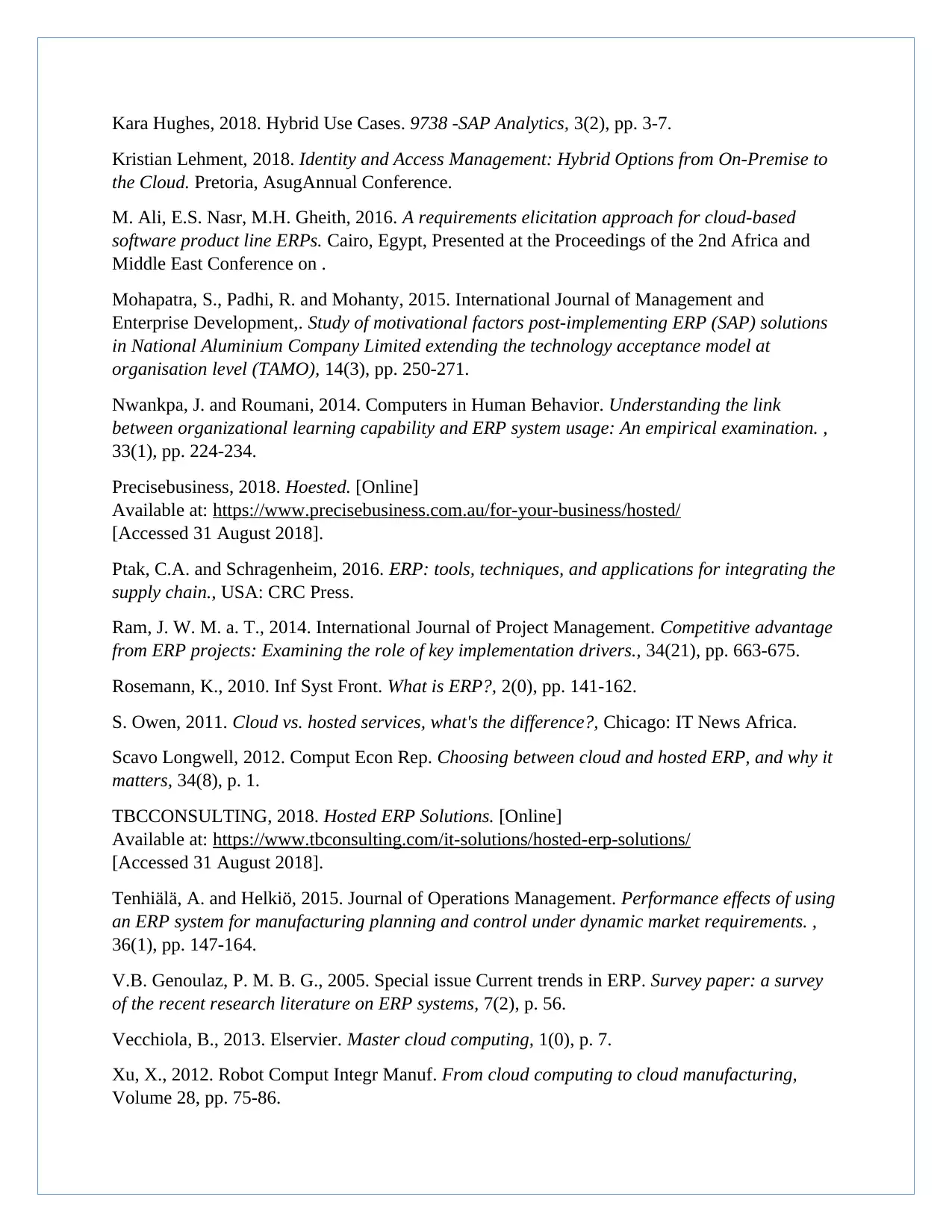
Kara Hughes, 2018. Hybrid Use Cases. 9738 -SAP Analytics, 3(2), pp. 3-7.
Kristian Lehment, 2018. Identity and Access Management: Hybrid Options from On-Premise to
the Cloud. Pretoria, AsugAnnual Conference.
M. Ali, E.S. Nasr, M.H. Gheith, 2016. A requirements elicitation approach for cloud-based
software product line ERPs. Cairo, Egypt, Presented at the Proceedings of the 2nd Africa and
Middle East Conference on .
Mohapatra, S., Padhi, R. and Mohanty, 2015. International Journal of Management and
Enterprise Development,. Study of motivational factors post-implementing ERP (SAP) solutions
in National Aluminium Company Limited extending the technology acceptance model at
organisation level (TAMO), 14(3), pp. 250-271.
Nwankpa, J. and Roumani, 2014. Computers in Human Behavior. Understanding the link
between organizational learning capability and ERP system usage: An empirical examination. ,
33(1), pp. 224-234.
Precisebusiness, 2018. Hoested. [Online]
Available at: https://www.precisebusiness.com.au/for-your-business/hosted/
[Accessed 31 August 2018].
Ptak, C.A. and Schragenheim, 2016. ERP: tools, techniques, and applications for integrating the
supply chain., USA: CRC Press.
Ram, J. W. M. a. T., 2014. International Journal of Project Management. Competitive advantage
from ERP projects: Examining the role of key implementation drivers., 34(21), pp. 663-675.
Rosemann, K., 2010. Inf Syst Front. What is ERP?, 2(0), pp. 141-162.
S. Owen, 2011. Cloud vs. hosted services, what's the difference?, Chicago: IT News Africa.
Scavo Longwell, 2012. Comput Econ Rep. Choosing between cloud and hosted ERP, and why it
matters, 34(8), p. 1.
TBCCONSULTING, 2018. Hosted ERP Solutions. [Online]
Available at: https://www.tbconsulting.com/it-solutions/hosted-erp-solutions/
[Accessed 31 August 2018].
Tenhiälä, A. and Helkiö, 2015. Journal of Operations Management. Performance effects of using
an ERP system for manufacturing planning and control under dynamic market requirements. ,
36(1), pp. 147-164.
V.B. Genoulaz, P. M. B. G., 2005. Special issue Current trends in ERP. Survey paper: a survey
of the recent research literature on ERP systems, 7(2), p. 56.
Vecchiola, B., 2013. Elservier. Master cloud computing, 1(0), p. 7.
Xu, X., 2012. Robot Comput Integr Manuf. From cloud computing to cloud manufacturing,
Volume 28, pp. 75-86.
Kristian Lehment, 2018. Identity and Access Management: Hybrid Options from On-Premise to
the Cloud. Pretoria, AsugAnnual Conference.
M. Ali, E.S. Nasr, M.H. Gheith, 2016. A requirements elicitation approach for cloud-based
software product line ERPs. Cairo, Egypt, Presented at the Proceedings of the 2nd Africa and
Middle East Conference on .
Mohapatra, S., Padhi, R. and Mohanty, 2015. International Journal of Management and
Enterprise Development,. Study of motivational factors post-implementing ERP (SAP) solutions
in National Aluminium Company Limited extending the technology acceptance model at
organisation level (TAMO), 14(3), pp. 250-271.
Nwankpa, J. and Roumani, 2014. Computers in Human Behavior. Understanding the link
between organizational learning capability and ERP system usage: An empirical examination. ,
33(1), pp. 224-234.
Precisebusiness, 2018. Hoested. [Online]
Available at: https://www.precisebusiness.com.au/for-your-business/hosted/
[Accessed 31 August 2018].
Ptak, C.A. and Schragenheim, 2016. ERP: tools, techniques, and applications for integrating the
supply chain., USA: CRC Press.
Ram, J. W. M. a. T., 2014. International Journal of Project Management. Competitive advantage
from ERP projects: Examining the role of key implementation drivers., 34(21), pp. 663-675.
Rosemann, K., 2010. Inf Syst Front. What is ERP?, 2(0), pp. 141-162.
S. Owen, 2011. Cloud vs. hosted services, what's the difference?, Chicago: IT News Africa.
Scavo Longwell, 2012. Comput Econ Rep. Choosing between cloud and hosted ERP, and why it
matters, 34(8), p. 1.
TBCCONSULTING, 2018. Hosted ERP Solutions. [Online]
Available at: https://www.tbconsulting.com/it-solutions/hosted-erp-solutions/
[Accessed 31 August 2018].
Tenhiälä, A. and Helkiö, 2015. Journal of Operations Management. Performance effects of using
an ERP system for manufacturing planning and control under dynamic market requirements. ,
36(1), pp. 147-164.
V.B. Genoulaz, P. M. B. G., 2005. Special issue Current trends in ERP. Survey paper: a survey
of the recent research literature on ERP systems, 7(2), p. 56.
Vecchiola, B., 2013. Elservier. Master cloud computing, 1(0), p. 7.
Xu, X., 2012. Robot Comput Integr Manuf. From cloud computing to cloud manufacturing,
Volume 28, pp. 75-86.

1 out of 16
Related Documents
Your All-in-One AI-Powered Toolkit for Academic Success.
+13062052269
info@desklib.com
Available 24*7 on WhatsApp / Email
![[object Object]](/_next/static/media/star-bottom.7253800d.svg)
Unlock your academic potential
© 2024 | Zucol Services PVT LTD | All rights reserved.





